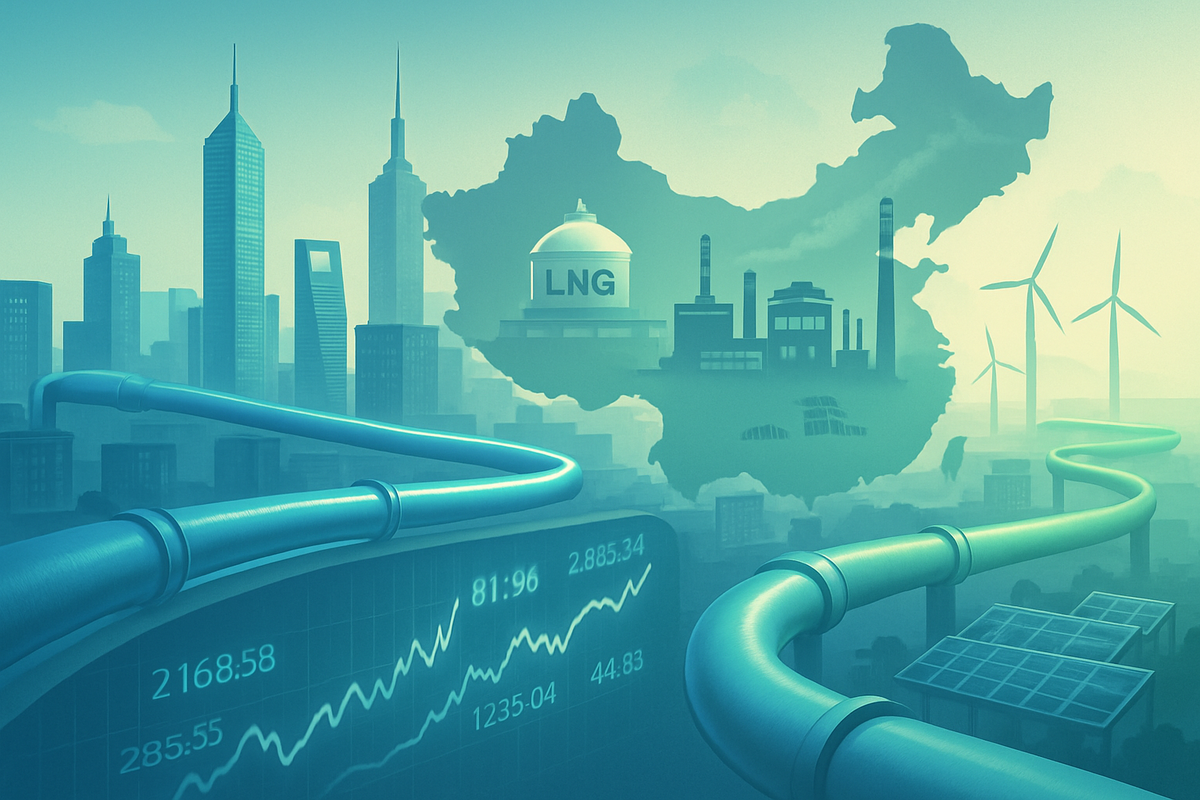
Shanghai, China – October 15, 2025 – Kunlun Energy (OTCMKTS: KLYCY), a prominent player in China's natural gas distribution landscape, has recently experienced periods of robust trading volume, sparking discussions across financial markets. This heightened activity, notably observed in late September and early October 2025, appears to be a direct reflection of both company-specific developments and the broader, evolving dynamics within the global and Chinese natural gas sectors. Investors and analysts are keenly watching these movements, interpreting them as potential indicators of significant shifts in market sentiment and strategic positioning within the energy industry.
The surge in trading volume for Kunlun Energy comes at a time when the natural gas market is navigating a complex interplay of geopolitical tensions, fluctuating demand, and strategic energy policy shifts, particularly in Asia. This confluence of factors suggests that the increased investor interest in Kunlun Energy could be signaling a re-evaluation of natural gas assets and their long-term prospects amidst a rapidly transforming global energy landscape.
Unpacking the Recent Trading Frenzy and Sector Undercurrents
Kunlun Energy (OTCMKTS: KLYCY) witnessed particularly strong trading on Wednesday, October 15, 2025, with 1,018 shares changing hands, a notable 60% increase over the prior session. The stock traded at $8.97, closing slightly up from $8.81. Another significant spike occurred on Thursday, September 25, 2025, when approximately 677 shares were traded, a 3% increase from the previous day's volume. On this date, the stock traded at $9.35. While these OTC Market volumes are significant percentage-wise for its secondary listing, it's important to note that the company's primary listing on the Hong Kong Stock Exchange (HKEX: 0135) generally sees much higher absolute volumes, with millions of shares traded daily, reflecting its substantial market presence.
These trading patterns coincided with key corporate news. Kunlun Energy recently announced an increase in its dividend to $0.185 per share, up from $0.16. This dividend is slated for payment on Friday, November 7, 2025, to shareholders of record as of Thursday, September 4, 2025. Such a positive adjustment in shareholder returns often attracts investor attention and can contribute to increased trading activity. However, not all news was positive; Zacks Research downgraded Kunlun Energy from a "hold" to a "strong sell" in a report dated Wednesday, August 27, 2025, contributing to an average "Sell" rating for the stock according to MarketBeat.com. Analyst downgrades can also trigger significant trading as investors adjust their portfolios based on revised outlooks.
The backdrop to these company-specific events is a global natural gas market characterized by both volatility and strategic recalibration. As of October 2025, healthy storage levels in the U.S. and Europe provide some stability, but the looming Northern Hemisphere winter and persistent geopolitical risks, especially in Eastern Europe, are expected to fuel price fluctuations. Global natural gas demand growth slowed to 1% year-on-year in the first half of 2025, a consequence of macroeconomic uncertainties and sustained high prices. This complex environment directly impacts distributors like Kunlun Energy, whose operational segments include Natural Gas Sales, Sales of Liquefied Petroleum Gas (LPG), Liquefied Natural Gas (LNG) Processing and Terminal, and Exploration and Production.
Market Movers: Winners and Losers in China's Evolving Gas Landscape
The robust trading in Kunlun Energy (OTCMKTS: KLYCY) (HKEX: 0135) underscores the intense competition and strategic re-positioning occurring within China's natural gas sector. As a subsidiary of the state-owned behemoth PetroChina (HKEX: 0857), Kunlun Energy benefits from a substantial upstream supply and extensive infrastructure. Its "hybrid business model," encompassing exploration and production alongside natural gas distribution, positions it to capitalize on the government's sustained "coal-to-gas" initiatives aimed at reducing pollution. However, it faces formidable competition from other major players and must navigate policy nuances and potential contractual disputes over downstream sales, which could impact its profitability and market share.
The broader Chinese natural gas market is dominated by the "Three Barrels"—PetroChina (HKEX: 0857), Sinopec (HKEX: 0386), and CNOOC (HKEX: 0883). These state-owned giants are poised to win from the national imperative for energy security, which prioritizes increased domestic natural gas production and the expansion of pipeline networks and LNG terminals, now partly managed by PipeChina. PetroChina, as the largest producer and importer, is particularly well-positioned. However, these companies also face the long-term challenge of diversifying into cleaner energy sources as China targets carbon neutrality by 2060, a strategic pivot already being explored by players like Sinopec with its ventures into geothermal energy.
Direct competitors and partners in the city gas distribution segment, such as ENN Energy Holdings (HKEX: 2688), China Gas Holdings (HKEX: 0384), China Resources Gas Group (HKEX: 1193), Beijing Gas (via Beijing Enterprises Holdings Ltd. (HKEX: 0392)), and Towngas China (HKEX: 1083), are also significantly impacted. These companies are direct beneficiaries of the "coal-to-gas" policy, which continues to drive demand in residential, commercial, and industrial sectors. Larger players among them are actively consolidating the market through acquisitions, potentially gaining substantial market share. However, many remain dependent on the "Three Barrels" for pipeline gas, making them vulnerable to supply and pricing disagreements. Furthermore, global price volatility for natural gas and LNG can squeeze margins, especially for those with less flexible pricing structures.
A significant policy shift, the revised Natural Gas Utilization Policy effective August 1, 2024, encourages natural gas use in specific transportation segments (LNG trucks, intercity buses, urban transit) while banning new natural gas-based hydrogen, methanol, and ammonia production projects. This creates targeted growth opportunities for distributors focused on transport, but closes off other potential industrial diversification avenues. Companies that can adapt swiftly to these policy shifts, secure stable supply, and optimize their cost structures will be best positioned to thrive in this increasingly competitive and regulated environment, while those unable to adjust may find themselves losing ground.
Broader Implications: A Barometer for China's Energy Future
The elevated trading volume observed in Kunlun Energy (OTCMKTS: KLYCY) (HKEX: 0135) in October 2025 serves as more than just a reaction to company news; it acts as a sensitive barometer for the intricate and often volatile landscape of China's energy future. This activity is deeply intertwined with three overarching industry trends: the ongoing energy transition, paramount energy security concerns, and the persistent specter of geopolitical tensions. Natural gas, while a fossil fuel, is increasingly viewed by China as a crucial "flexible regulator" for its rapidly expanding renewable energy grid, balancing intermittency and ensuring stable supply. The government's 14th Five-Year Plan aims to significantly increase natural gas's share in the energy mix, even as recent policies emphasize "orderly" development over aggressive conversion, reflecting a nuanced approach to energy evolution.
This investor interest in Kunlun Energy can be interpreted as a strong signal of confidence in China's long-term natural gas demand, driven by continued urbanization, industrial needs, and the strategic push for gas-fired power generation to stabilize the grid. Furthermore, it highlights Kunlun Energy's pivotal role in China's energy security strategy, particularly through its extensive pipeline and LNG terminal operations. The government's unwavering focus on boosting domestic natural gas production, diversifying import channels (including overland pipelines), and expanding strategic reserves directly benefits companies like Kunlun Energy, which are integral to these efforts. There's also speculation that the trading volume could anticipate significant mergers, acquisitions, or internal asset injections from its parent, PetroChina (HKEX: 0857), as the state-owned energy complex seeks to optimize and streamline its vast assets.
The ripple effects of such market activity are profound. For competitors in the natural gas distribution sector, such as China Resources Gas Group (HKEX: 1193) and Beijing Enterprises Holdings Ltd. (HKEX: 0392), increased investor confidence in Kunlun Energy could heighten competitive pressure. It might signal that Kunlun Energy is gaining strategic ground, potentially prompting rivals to re-evaluate their own expansion plans, operational efficiencies, or M&A strategies. For its parent, PetroChina (HKEX: 0857), a strong performance by Kunlun Energy reinforces the efficacy of its strategic platform for natural gas retail and could encourage further asset consolidation or collaborative projects within the group. Upstream and midstream partners supplying gas to Kunlun Energy's vast network also stand to benefit from robust and sustained demand.
From a regulatory standpoint, sustained investor interest and healthy trading in key distributors like Kunlun Energy could influence the pace and direction of future policy implementation. It might lend further impetus to the National Development and Reform Commission's (NDRC) plans for accelerated pipeline network expansion and storage capacity build-up, addressing existing shortfalls. It could also lead to refinements in pricing mechanisms, balancing market stability and investment attractiveness with consumer affordability, a sensitive issue in China. Historically, periods of strong government policy emphasis on natural gas, such as the aggressive "coal-to-gas" pushes and the structural reforms that led to the establishment of PipeChina in 2019, have consistently reshaped market dynamics and investor outlooks for major players. Kunlun Energy's current trading surge, therefore, is not an isolated event but a reflection of the market's ongoing response to China's ambitious, yet carefully managed, energy transition.
The Road Ahead: Navigating China's Evolving Energy Landscape
Looking forward, the trajectory for Kunlun Energy (OTCMKTS: KLYCY) (HKEX: 0135) and China's broader natural gas sector is one of dynamic evolution, characterized by both sustained growth and significant strategic shifts. In the short term, spanning the coming months into 2026, China's natural gas demand is projected to see moderate increases, driven primarily by robust industrial sectors—including steelmaking, ceramics, and the burgeoning electric vehicle and solar panel manufacturing—alongside a growing contribution from gas-fired power generation. While 2025 has seen a recalibration and anticipated decline in China's LNG imports due to weaker industrial demand and increased domestic and pipeline supplies, a strong rebound in LNG import demand is widely expected in 2026. Government policy, as articulated in the "2024-2025 Energy Conservation and Carbon Reduction Action Plan," emphasizes "orderly" development of gas consumption, prioritizing local supply and affordability, and a critical focus on expanding pipeline and storage infrastructure to bolster energy security.
Kunlun Energy's recent operational performance in the first half of 2025 showcased strong natural gas sales volumes and user additions, with its LNG value chain demonstrating robust synergies. However, a slight decrease in profit attributable to shareholders and mixed analyst sentiment—ranging from a "strong sell" downgrade by Zacks Research to "Buy" ratings from others—suggests a nuanced outlook despite the recent strong trading volume. The company's stock has also shown a downward trend in its 50-day and 200-day moving averages, indicating that while individual trading spikes occur, the broader sentiment requires careful monitoring.
Longer term, from 2027 and beyond, China's natural gas demand is forecast to continue growing, albeit at a moderating pace, potentially peaking between 2035 and 2040. Domestic production will continue to rise, and while LNG imports are expected to rebound and exceed 100 million tons by 2027, they are projected to gradually decline post-2030s as renewables gain further dominance. Natural gas's role will increasingly be defined by its ability to act as a transition fuel, supporting decarbonization efforts while ensuring energy security, even as it faces escalating competition from rapidly expanding and increasingly cost-effective renewable energy sources.
To navigate this evolving landscape, companies like Kunlun Energy must undertake crucial strategic pivots. Diversification into integrated multi-energy systems—encompassing gas, electricity, cooling/heating, hydrogen, and special gases—is paramount. Kunlun Energy's existing efforts in distributed PV projects and its first integrated energy demonstration project in Chongqing Tongliang are steps in this direction. Optimizing its extensive LNG value chain, including its receiving terminals and truck-loading capabilities, will be critical for managing supply volatility and enhancing profitability. Expansion into green transportation fuels, exemplified by its successful LNG marine refueling services, presents a significant growth opportunity. Alongside these, rigorous cost control, operational efficiency, and strategic asset management will be essential to sustain profitability amidst potential demand moderation and increased competition.
Emerging market opportunities lie in specific industrial sectors, the growing need for gas-fired power generation for grid stability, and the massive investment required for storage infrastructure development. However, challenges persist, including the potential for slowing overall gas demand growth, the impact of high global LNG spot prices, profitability issues for storage facilities, and geopolitical trade tensions. Considering these factors, a "Controlled and Diversified Growth" scenario appears most likely: China's natural gas demand will grow moderately, balanced by diversified supply sources, and Kunlun Energy will achieve steady growth in its core gas business while successfully integrating new energy components and maintaining operational efficiency. Other scenarios, such as an accelerated green transition or an energy security-driven gas expansion, remain possibilities, each presenting distinct outcomes for the company and the sector.
Comprehensive Wrap-Up: A Market in Transition
The recent surge in Kunlun Energy's (OTCMKTS: KLYCY) (HKEX: 0135) trading volume is a vivid illustration of the complex forces shaping China's natural gas market. It reflects not only immediate reactions to company-specific developments, such as dividend increases and analyst downgrades, but also deeper investor engagement with the profound shifts occurring across the broader energy sector. As China meticulously balances its dual imperatives of energy security and ambitious decarbonization, natural gas finds itself in a pivotal, albeit transitional, role.
Moving forward, the Chinese natural gas market is poised for continued growth, though its trajectory will be increasingly influenced by policy directives that favor "orderly" development, expanded domestic production, and diversified import strategies. The emphasis on strengthening infrastructure, particularly pipelines and storage, underscores the nation's commitment to energy resilience. For major players like Kunlun Energy, the market will demand heightened adaptability, strategic diversification into integrated energy solutions, and relentless pursuit of operational efficiencies.
The lasting impact of these trends will be a more mature, competitive, and diversified energy landscape in China. Natural gas will remain an essential bridge fuel, but its long-term growth will be constrained by the accelerating deployment of renewables and the strategic necessity to reduce carbon emissions. Companies that can effectively leverage their existing infrastructure, innovate in new energy domains, and align with national strategic priorities will be best positioned for sustained success.
Investors should closely monitor several key indicators in the coming months and years: the implementation and evolution of China's energy policies, particularly those related to "coal-to-gas" conversions and renewable energy integration; global natural gas price trends and their impact on import economics; Kunlun Energy's progress in its multi-energy system diversification and asset optimization; and any further consolidation or strategic partnerships within the highly competitive Chinese natural gas distribution sector. These factors will collectively determine the future profitability and market positioning of companies operating in this critical segment of the global energy market.
This content is intended for informational purposes only and is not financial advice





